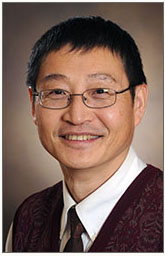George X. Ding, PhD, FAAPM
More Information
The goal of his work and research is to improve the therapeutic index - to enhance the tumor control while minimizing the toxicity of the treatment to critical normal tissues by using and developing state-of-the-art treatment techniques to improve accuracy and precision of radiotherapy. His research interests include: accurate patient treatment planning, accurate dose calibration for radiation beams, quality assurance (QA) in reference dosimetry and patient treatment planning systems, Image Guided Radiation Therapy (IGRT), adaptive radiotherapy, stereotactic body radiation therapy (SBRT), reducing imaging guidance dose to patients, application of highly accurate Monte Carlo techniques in patient dose calculations, small-field dosimetry, developing new treatment delivery techniques using electrons and photon beams, developing accurate and practical dose calculation algorithms for low energy photon beams.
Dr. Ding is an expert in radiation dosimetry and application of Monte Carlo techniques in radiotherapy. His earlier work is at the heart of the Monte Carlo user code, BEAM, used throughout the world for simulation of radiation beams produced by medical accelerators. His work on water-to-air stopping-power ratios provides important dosimetric data for radiotherapy reference dose calibration. This new understanding led to a new reference depth for more accurate electron beam reference dose calibration. Both recent American Association of Physicists in Medicine (AAPM) dosimetry protocol TG-51 and the International Atomic Energy Agency (IAEA) TRS 398 protocol adopted the new reference depth for electron beam calibration. He pioneered a series of studies on the use of Monte Carlo techniques to estimate radiation exposure for patients who undergo image-guidance procedures using kilovoltage Cone Beam CT.
Dr. Ding has supervised over a dozen MSc, PhD students and residents, served as an External Examiner for many PhD Theses in different countries, served as a reviewer for 14 peer-reviewed journals, as well as an external reviewer for book proposals. He has served as a research grant reviewer for the National Institutes of Health (NIH), National Institute of Biomedical Imaging and Bioengineering (NIBIB), the Natural Sciences and Engineering Research Council of Canada (NSERC), Canadian Institutes of Health Research, Ontario Research Fund, and many other government, university, and private funding sources. He has served as PI and Co-PI of research projects funded by external agencies, including NIH, universities and commercial companies.
Dr. Ding has been an invited speaker to international and national presentations. He has authored over 50 peer review articles, 5 book chapters, and over 100 published abstracts and presentations, many of those as first or senior author.
He currently serves on the committee of The National Academies on Research Directions in Human Biological Effects of Low Level Ionizing Radiation; chairs AAPM Task Group report-180; serves on the International Commission on Radiation Units and Measurements Report Committee; the AAPM Therapy Physics Committee, the AAPM Calibration Laboratory Accreditation Executive Committee, and the AAPM Biological Effects Subcommittee addressing biological effects of radiation therapy.
Dr. Ding earned a Ph.D. in radiation physics from Carleton University and the National Research Council of Canada. He is a Fellow of the Canadian College of Physicists in Medicine (FCCPM) and a Fellow of the American Association of Physicists in Medicine (FAAPM).
